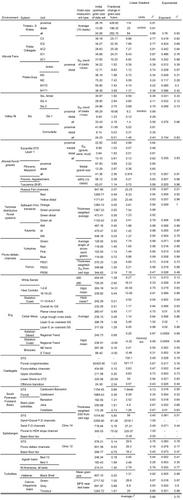当前位置:
X-MOL 学术
›
Earth Sci. Rev.
›
论文详情
Our official English website, www.x-mol.net, welcomes your feedback! (Note: you will need to create a separate account there.)
Grain size from source to sink – modern and ancient fining rates
Earth-Science Reviews ( IF 12.1 ) Pub Date : 2024-02-02 , DOI: 10.1016/j.earscirev.2024.104699 Tony Reynolds
Earth-Science Reviews ( IF 12.1 ) Pub Date : 2024-02-02 , DOI: 10.1016/j.earscirev.2024.104699 Tony Reynolds

|
A unique synthesis of grain size-distance data is presented, comparing, for the first time, grain size and fining trends in a wide range of modern and ancient axial sediment dispersal systems, and tracking grain-size from source to sink across several sedimentary basins. In general, grain-size decreases exponentially with distance down system, and modern and ancient examples fine at broadly comparable rates in similar depositional settings. Linear fining rates vary by eight orders of magnitude, being higher in coarser-grained settings. Very few data sets have a median grain size between 1 and 5 mm in diameter, supporting the idea that material of this calibre is rare. Alluvial fans fine at the highest rates, by up to 450 cm/km (216%/km) in modern and 115 cm/km (427%/km) in ancient examples, but more typically by around 1 to 12 mm/km (87 to 1%/km), whereas fluvial gravels fine by 0.8 to 4 mm/km (0.4 to 5%/km). Sand-prone systems fine more slowly, by a few tens of microns per kilometre or less: 1 to 23 μm/km (0.25 to 2.5%/km) in distributive fluvial systems, ∼1 to 8 μm/km (∼1 to 6%/km) in fluvio-deltaic channels, 0.2 to 44 μm/km (0.08 to 14%/km) in ergs, and from 0.45 to 29 μm/km (0.18 to 7%/km) in basin-plain turbidites. At the basin scale, fining rates increase where gravels pinch out down-system at the fluvial gravel-sand transition, and where sands pinch out at the toe of the shoreface. Modern fluvial gravel-sand transitions are relatively well characterised, with fining rates ranging from 71 to 0.2 mm/km (483 to 2%/km), and lower rates and wider transitions in wider, longer rivers, insights that appear applicable to the rock record. Downstream fining predominantly reflects selective deposition of coarser material and preferential transport of finer grains, with subsidence increasing fining rates as coarser grains are preferentially extracted up-dip to form stratigraphy. Across short segments, grain-size can increase down system as a result of winnowing, bypass, or lateral sediment input. Comminution is largely considered a secondary factor in rivers, but important in ergs, where lateral sediment input can overwhelm downstream fining effects, and grain-size sorting across dunes may obscure longer downwind trends. In deep water, when the slope is bypassed, basin-floor fans can fine at rates comparable to contemporaneous up-dip fluvial channels, by 30 μm/km (5%/km), but if sediment is deposited on the slope, fining rates increase (225 μm/km 75%/km) as distances are shorter. Axial flow lines across basin-plain turbidites with diverse grain-size, and dimension, can be closely comparable on mass-balance plots, suggesting that the properties of one bed could inform predictions of those of another. As yet there are no studies of fining rates in conglomeratic deep-water systems, where the transition from conglomerate to sand-dominated systems is of particular interest, given its importance for fining rates in fluvial systems. The dataset has potential to constrain computer simulation models of sediment calibre, and subsurface models that address, for example, aquifer flow, and petroleum migration.
中文翻译:

从源头到汇的粒度——现代和古代的细化率
提出了粒度-距离数据的独特综合,首次比较了各种现代和古代轴向沉积物扩散系统中的粒度和细化趋势,并跟踪了几个沉积盆地从源头到汇的粒度。一般来说,粒度随着系统距离的降低呈指数级减小,并且现代和古代的例子在相似的沉积环境中以大致可比的速率减小。线性细化率变化八个数量级,粗粒度设置中线性细化率更高。很少有数据集的中值粒径在直径 1 到 5 毫米之间,这支持了这种口径的材料很稀有的观点。冲积扇的细化率最高,在现代例子中高达 450 厘米/公里(216%/公里),在古代例子中高达 115 厘米/公里(427%/公里),但更常见的是约 1 至 12 毫米/公里( 87 至 1%/公里),而河流砾石细化 0.8 至 4 毫米/公里(0.4 至 5%/公里)。易沙的系统细化速度较慢,每公里细化几十微米或更小:分布河流系统中为 1 至 23 μm/km(0.25 至 2.5%/km),∼1 至 8 μm/km(∼1 至 6) %/km)在河流三角洲河道中,0.2至44μm/km(0.08至14%/km)在尔格中,以及0.45至29μm/km(0.18至7%/km)在盆地平原浊积岩中。在盆地尺度上,河流砾石-砂过渡处砾石尖灭处以及砂在岸面趾部尖灭处的细化率增加。现代河流砾石-砂过渡区的特征相对较好,细化率范围为 71 至 0.2 毫米/公里(483 至 2%/公里),在更宽、更长的河流中,速率更低,过渡区更宽,这些见解似乎适用于岩石记录。下游细化主要反映了较粗物质的选择性沉积和较细颗粒的优先输送,沉降增加了细化速率,因为较粗的颗粒优先向上倾提取以形成地层。在短段上,由于风选、旁路或侧向沉积物输入,颗粒尺寸可能会增加向下的系统。粉碎在很大程度上被认为是河流的次要因素,但在尔格中很重要,侧向沉积物输入可以压倒下游的细化效应,而沙丘上的粒度排序可能会掩盖较长的顺风趋势。在深水中,当斜坡被绕过时,盆底扇的细化速度可与同时代的上倾河道相媲美,即 30 μm/km (5%/km),但如果沉积物沉积在斜坡上,则细化率会降低。随着距离变短,增加(225 μm/km 75%/km)。跨越不同粒度和尺寸的盆地平原浊积岩的轴流线可以在质量平衡图上进行密切比较,这表明一个床的特性可以为另一个床的特性提供信息。迄今为止,还没有关于砾岩深水系统中的澄清率的研究,考虑到从砾岩到砂为主的系统的转变对于河流系统中的澄清率的重要性,它特别令人感兴趣。该数据集有可能限制沉积物口径的计算机模拟模型以及解决含水层流动和石油运移等问题的地下模型。
更新日期:2024-02-02
中文翻译:

从源头到汇的粒度——现代和古代的细化率
提出了粒度-距离数据的独特综合,首次比较了各种现代和古代轴向沉积物扩散系统中的粒度和细化趋势,并跟踪了几个沉积盆地从源头到汇的粒度。一般来说,粒度随着系统距离的降低呈指数级减小,并且现代和古代的例子在相似的沉积环境中以大致可比的速率减小。线性细化率变化八个数量级,粗粒度设置中线性细化率更高。很少有数据集的中值粒径在直径 1 到 5 毫米之间,这支持了这种口径的材料很稀有的观点。冲积扇的细化率最高,在现代例子中高达 450 厘米/公里(216%/公里),在古代例子中高达 115 厘米/公里(427%/公里),但更常见的是约 1 至 12 毫米/公里( 87 至 1%/公里),而河流砾石细化 0.8 至 4 毫米/公里(0.4 至 5%/公里)。易沙的系统细化速度较慢,每公里细化几十微米或更小:分布河流系统中为 1 至 23 μm/km(0.25 至 2.5%/km),∼1 至 8 μm/km(∼1 至 6) %/km)在河流三角洲河道中,0.2至44μm/km(0.08至14%/km)在尔格中,以及0.45至29μm/km(0.18至7%/km)在盆地平原浊积岩中。在盆地尺度上,河流砾石-砂过渡处砾石尖灭处以及砂在岸面趾部尖灭处的细化率增加。现代河流砾石-砂过渡区的特征相对较好,细化率范围为 71 至 0.2 毫米/公里(483 至 2%/公里),在更宽、更长的河流中,速率更低,过渡区更宽,这些见解似乎适用于岩石记录。下游细化主要反映了较粗物质的选择性沉积和较细颗粒的优先输送,沉降增加了细化速率,因为较粗的颗粒优先向上倾提取以形成地层。在短段上,由于风选、旁路或侧向沉积物输入,颗粒尺寸可能会增加向下的系统。粉碎在很大程度上被认为是河流的次要因素,但在尔格中很重要,侧向沉积物输入可以压倒下游的细化效应,而沙丘上的粒度排序可能会掩盖较长的顺风趋势。在深水中,当斜坡被绕过时,盆底扇的细化速度可与同时代的上倾河道相媲美,即 30 μm/km (5%/km),但如果沉积物沉积在斜坡上,则细化率会降低。随着距离变短,增加(225 μm/km 75%/km)。跨越不同粒度和尺寸的盆地平原浊积岩的轴流线可以在质量平衡图上进行密切比较,这表明一个床的特性可以为另一个床的特性提供信息。迄今为止,还没有关于砾岩深水系统中的澄清率的研究,考虑到从砾岩到砂为主的系统的转变对于河流系统中的澄清率的重要性,它特别令人感兴趣。该数据集有可能限制沉积物口径的计算机模拟模型以及解决含水层流动和石油运移等问题的地下模型。



























 京公网安备 11010802027423号
京公网安备 11010802027423号